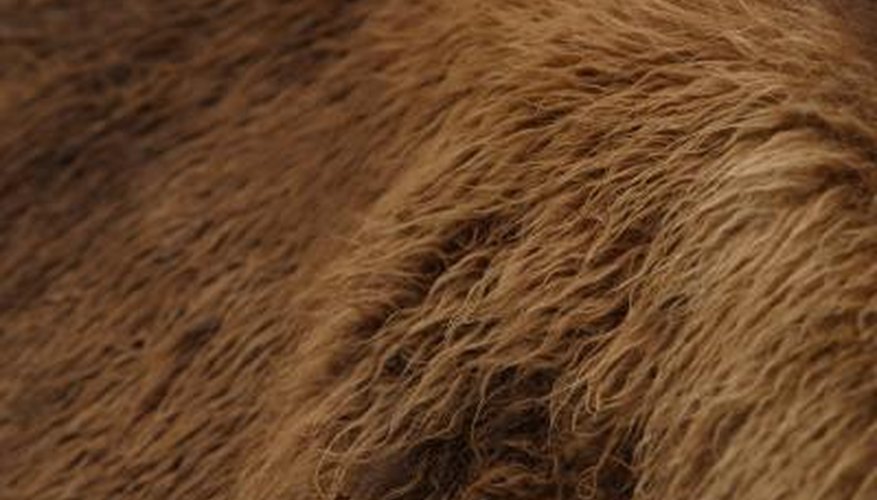
Human beings have been tanning pelts for thousands of years. During most of that time, they did not have modern chemicals and were forced to rely on what can only be described as more "traditional" measures. Traditional ways of tanning pelts -- that are generally quite inexpensive -- are still used by many people today, and there is no reason that you can't count yourself among them. The two most common traditional methods of tanning hides are brain tanning and bark tanning.
Salt and Dry the Pelt
Lay the hide on a flat surface, fur-side down. Rub rock salt into the fleshy side of the pelt, using approximately 1 pound of salt for every pound of hide. Rub the salt thoroughly into every fold of the pelt. Any spot left unsalted is a place left unprotected, and these areas are subject to decay or insect problems. Tilt the work surface so that the liquids can drain from the hide. After 24 hours, lightly scrape the hide with a dull knife to remove as much of the liquid on the hide as possible. Rub more salt into the hide and allow it to dry thoroughly over the next 10 to 14 days.
Soak the Pelt in Water
Fill a barrel with water and place the dried hide inside, stirring it occasionally. The idea is to hydrate the hide and make it as soft and pliable as possible. Dump the water at least a couple of times and replace it with clean water. Only soak the hide until the skin has re-hydrated and is soft and pliable. For some skins this may take only a couple of hours; for others it can take considerably longer. Check the hide often.
Scrape the Hide Clean and Soak it in Borax
Stretch the hide, fur-side down, over a large, flat table that is waist high. Use a bone scraper or an old, dull hacksaw blade to carefully scrape all of the flesh and fat off of the inside of the hide. Also carefully scrape the thin, shiny membrane from the inside of the hide. Use caution to avoid puncturing the hide or scraping it so hard that holes or tears appear. Place the scraped hide in a plastic trash can filled with water and Borax, about 1 ounce of Borax per gallon of water. This will clean the hide and begin the softening process. Stir the hide with a wooden paddle to make sure it is thoroughly clean.
Scud the Pelt
Lay your pelt on a flat table, flesh-side up, and use the dull side of a large knife to scrape -- or scud -- any remaining flesh, fat or other debris off the skin, then rinse it in a barrel of clean water. Squeeze most of the water out of the hide and lay it flat on a table, flesh-side up.
Tanning Pelts With Brains
The brains of the animal may be used in the tanning process, or a cow, pig or horse's brain may be purchased at your local butcher shop. Soak the hide in water then blot it almost dry with towels, leaving it damp. Bring 1 pound of brain matter to a boil in 2 gallons of distilled water. Allow it to cool slightly. Paint the brain liquid onto the skin side of the pelt while it is still warm and allow it to soak the pelt for 24 hours. Do not get any of the brain matter on the fur side of the pelt.
Stretching the Hide
Stretch the hide tight and nail it to a board or stretch the hide over a frame. Use a canoe paddle, ax handle or similar piece of smooth wood to work the hide, rubbing it over and over to break any fibers in the skin of the hide, leaving the hide smooth and soft.
Tanning with Bark
Buy shredded tree bark (mulch) from your local nursery. You will need 2 pounds of shredded bark. Grind the shredded bark up any way you can. Chop it up with an ax or use a grain mill on a coarse setting if you have one. The finer the bark is ground, the more tannin you will get from it, and tannin is the main ingredient for bark tanning. Place the ground bark in a stainless steel pot, cover it with distilled water and boil for one hour. Mix half of the boiled tannin with an equal amount of distilled water and paint a light coating of the bark tannin onto the flesh side of the pelt. Leave it overnight. The following day, paint a more generous, full-strength coating of tannin onto the pelt and leave it for 24 hours. Stretch and lightly pound the pelt with a wooden canoe paddle to soften the pelt.
Smoke the Hide
Position the hide over a smoky fire so the hide is in the shape of a tee-pee. Allow the smoke to permeate the hide until the hide is a rich brown color through and through. The smoke will keep the hide from hardening again if it should become wet. Do this step, regardless of whether the pelt was tanned with brains or tree bark.
References
Writer Bio
Larry Parr has been a full-time professional freelance writer for more than 30 years. For 25 years he wrote cartoons for television, everything from "Smurfs" to "Spider-Man." Today Parr train dogs and write articles on a variety of topics for websites worldwide.



